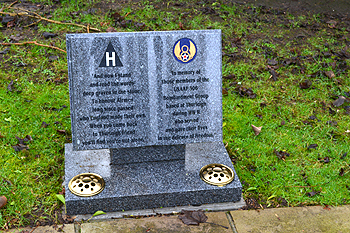Thurleigh in World War Two
![Bombing up a B-17 Flying Fortress [Z50/122/50]](/CommunityHistories/Thurleigh/ThurleighImages/Bombing up a B-17 Flying Fortress [Z50-122-50].jpg)
Bombing up at B-17 Flying Fortress [ref: Z50/122/50]
Much of the story of Thurleigh in World War Two revolves around the airfield, which was built in 1941. Before that the parish had been on the receiving end of some stray enemy action. On 18th November 1940 a high explosive bomb was dropped on Backnoe End [ref: WW2/AR/CO2/2]. Two days later another high explosive bomb fell five hundred yards east of Scald End Farm [ref: WW2/AR/CO2/2]
Almost as soon as the airfield was constructed it received enemy attention. On 11th April 1941 eight 50 kilogramme bombs were dropped on the airfield, damaging the runway. Four more bombs fell at Manor Farm [ref: WW2/AR/CO2/3]. The airfield was attacked again on 12th August 1941 when eight 50 kilogramme bombs were dropped along the northern boundary, superficially damaging the runway and bursting a water main [ref: WW2/AR/CO2/3].
On 18th May 1942 an RAF aircraft crashed at the airfield [ref: WW2/AR/CO2/3]. Graham Smith in his volume Hertfordshire and Bedfordshire Airfields in the Second World War identifies this as a Vickers Wellington of 18 Operational Training Unit which had been engaged in night flying practice. It was shortly after this that the airfield was converted and handed over to the 306th Bombardment Group of the 8th United States Army Air Force. They flew Boeing B-17 Flying Fortresses, four-engined heavy bombers.
![USAAF personnel on the control tower at Thurleigh airfield [Z50-122-45]](/CommunityHistories/Thurleigh/ThurleighImages/USAAF personnel on the control tower at Thurleigh .jpg)
USAAF personnel on the control tower at Thurleigh airfield [ref: Z50/122/45]
Rutters Cottages was the site of a tragedy on 28th November 1942 when an RAF Havoc nightfighter crashed nearby. It had come from nearby RAF Twinwoods, just outside Clapham and its pilot, Sergeant Leonard James Casey was killed. He was a New Zealander, from Herne Bay, Auckland, aged just 21; he is buried in Kempston Cemetery [ref: WW2/AR/C2/182].
On 30th December 1943 two 1,000 pound British bombs were jettisoned at Rutters Farm [ref: WW2/AR/CO2/3]. A serious incident occurred on 20th January 1944 when a training exercise involving poisoned gas at the airfield took place. Some of the gas drifted into neighbouring fields affecting Arthur Filsell of Bury’s Field Farm [ref: WW2/AR/CO2/3]. British incendiary bombs were dropped at the airfield on 31st March 1944 [ref: WW2/AR/CO2/3].
The infamous V1 or Doodlebug was a pilotless rocket aimed at Britain from sites in Nazi occupied Europe. London was the principal target but Bedfordshire did get the odd strike. One such occurred on 6th October 1944 when one exploded 200 yards south-east of Brook Farm. The 850 kilogramme high explosive warhead did superficial damage to the farmhouse and buildings [ref: WW2/AR/CO2/3].
On 22nd October 1944 another tragedy took place at the airfield. A mid-air collision between two Flying Fortresses took place, one, according to Air Raid Precautions reports from the USAAF base at Podington, the other from Chelveston in Northamptonshire with all crew being killed. A B-17 typically had a crew of ten, so one would expect around twenty fatalities, however, only seven deaths can definitely be placed at the scene by cross-referencing the American Battle Monuments Commission database and that produced by the Imperial War Museum. All are buried at the American cemetery at Madingley and their details are as follows:
- Staff Sergeant Harold E Boling from Indianapolis, Indiana 422 Squadron
- Staff Sergeant Nick Colaiuta from Oregon – 422 Squadron
- 2nd Lieutenant Robert Coverstone from California – 422 Squadron
- Staff Sergeant Ersel E Lennier from Arkansas or Arizona – 422 Squadron
- Sergeant Philip R Mifsud from Pennsylvania – 364 Squadron
- 2nd Lieutenant Frank Watkins from Texas – 364 Squadron
- Staff Sergeant Albert B Zieglmeier from Minnesota – 422 Squadron

Thurleigh USAAF Memorial, January 2015